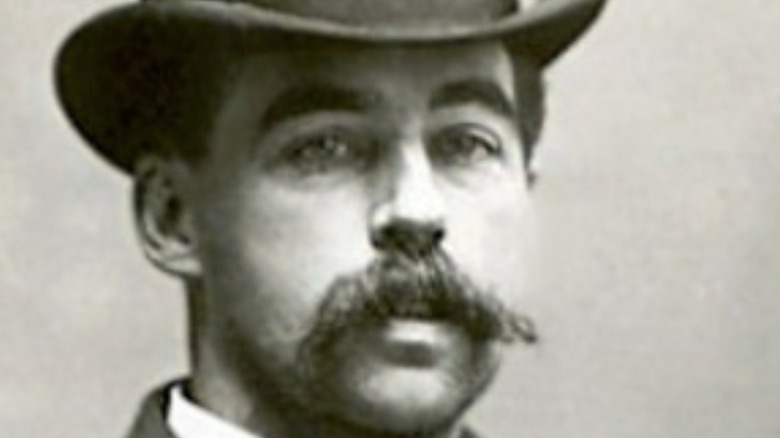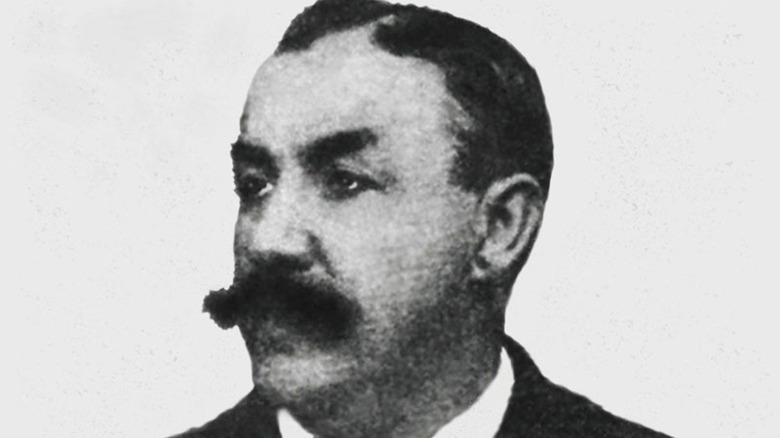Frank Geyer, The Lawman Who Put An End To The Devil In The White City's Reign Of Terror
The crimes of H.H. Holmes made him one of the most prolific and ingenious serial murderers in history. With a possible body count that ranges from 20 to more than 200, Holmes used a series of financial schemes and insurance frauds to build a considerable amount of wealth (via Biography). The majority of his major crimes began when he moved to Chicago to work as a pharmacist. He was able to buy the business from the owner's widow and erect a three-story mansion across the street (per History). It was in the mansion that Holmes took the lives of unsuspecting victims, many of whom he lured there from the 1893 World's Columbian Exposition that the city hosted. Holmes constructed a series of secret passages, hidden rooms, and trap doors to help hide and dispose of the many bodies the house consumed. His motive was financial — Holmes would charm women and then strip them of their valuables and assets. Often, Holmes took out life insurance policies on his victims first, increasing the take from their deaths.
Holmes is reported to have had a dissection room for the bodies in the basement of his massive house. It was there that Holmes would strip the bodies down to bare bones, selling skeletons to medical schools in the area. Holmes had long since used corpses and skeletons as a means to make money. Years before, he worked his way through school by taking out life insurance policies on fake people and getting paid out when he presented stolen corpses as proof of their deaths. But it was a financial scam that served as his eventual undoing.
Enter Detective Frank Geyer
Some might be surprised to find out that H.H. Holmes didn't always act alone — he enlisted the aid of another con artist named Benjamin Pitezel. The two men cooked up a scheme that involved Holmes taking a $10,000 life insurance policy out on his partner, who then faked his death (per History). After the payout, the two men were to split the proceeds. Holmes had other ideas.
Holmes was imprisoned briefly in the Midwest for fraud (per Britannica). When he was released, he reconnected with the "dead" Pitezel in Philadelphia. He murdered his partner but convinced his widow Carrie that he was alive and had gone into hiding. He convinced her to leave with him and bring three of her children in tow. Holmes is believed to have thought that these particular kids knew about the insurance scam, and he eliminated them, too. He and Carrie Pitezel were arrested on November 17, 1894. Holmes insisted that his partner was alive and had the missing children with him. But Detective Frank Geyer decided to work on his hunch that the three Pitezel children had been murdered (via Rebecca Frost).
Geyer undertook the arduous task of retracing Holmes' steps after he had connected with Carrie Pitezel. This proved to be confusing, as Holmes had moved the entourage around various parts of the United States under different names and had even stayed across the border in Toronto for a time. But Geyer's determination to find out what happened to Alice, Nellie, and Howard Pitezel eventually paid off.
Geyer makes chilling discoveries
In his book "The Holmes-Pitezel Case," Frank Geyer wrote that he came up with a brilliant strategy (via Rebecca Frost). When he visited a city he suspected Holmes had hidden in, he organized a press conference. The papers ran photos of Holmes, along with pertinent information that would trigger someone's memories. Who he was traveling with, stories he might have told a landlady or real estate agent, etc. The plan worked, leading Geyer to a home in Indianapolis that Holmes had recently rented, where he discovered the burned remains of Howard Pitezel. Geyer was also successful in Toronto, finding out that a man fitting Holmes' description had been in the city. Geyer located a place rented by his suspect and made a chilling discovery — buried in the basement was a large trunk containing the bodies of Alice and Nellie. It's believed that Holmes forced them into the trunk and flooded it with lethal gas (per Smithsonian Magazine).
Holmes was put on trial for the murder of Benjamin Pitezel and found guilty. Though there were possibly scores of victims over the years, prosecutors went with the case that they believed was a sure bet. Their risk paid off — Holmes was found guilty on the charge of murder and sentenced to death. History reports that at one point, Holmes made the statement, "I was born with the devil in me. I could not help the fact that I was a murderer, no more than a poet can help the inspiration to sing." The killer was hung at the gallows in Philadelphia on May 7, 1896.


